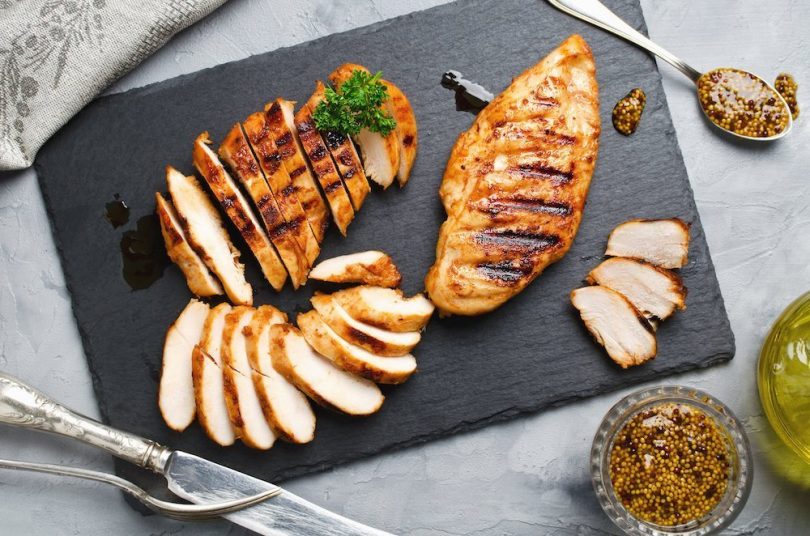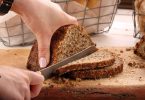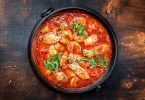There are several reasons of chicken going rubbery.
Why is Chicken Rubbery?
Overcooking your chicken breasts or other parts may be a cause of its hard chewing, as protein fibers tend to lose their elasticity while cooking too much and they go chewy because of being sensitive to heat. So, be careful and keep to the necessary temperature when cooking the meat, as under-cooking it will also cause its rubbery texture appear.
If you are too afraid of the infections and microbes existing in raw or undercooked meat, try to heat the meat until it reaches 165 F internal temp, in this case all the harmful organisms will disappear, but the meat will keep on being tender and mouthwatering. But with high temps the chicken meat runs out of water very fast and it goes spongy or chewy.
Dry chicken will also taste rubbery and unpleasant, so to avoid this problem of dryness, you should cover the chicken meat while marinating it or when the cooking is finished, as uncovered meat will be prone to dryness in any case. So, you ‘d better wrap it into some foil or plastic sheet. Chicken is lean meat and it’s prone to drying out while grilling or smoking it, so keep on pouring some marinade or oil on it during the smoking process, it will give a wonderful taste and texture to your grilled poultry dish.
Also, when purchasing your chicken breasts, file or other parts, ask about the farming conditions of an animal, as it really matters a lot. The better it’s fed and raised, the better meat texture it will obtain.
Is Chewy Chicken Over or Undercooked?
I t might be both variants here. If you cooked the chicken chests or thighs slow and long, it might be overcooked and dried out. If you didn’t cook it properly and it took a short time period for you, it might be undercooked and chewy, of course. If it looks a little pink outside or inside, it is certainly undercooked. The best solution is buying an instant thermometer, which will show you the inner temp of the meat, and if it’s around 165-170 F, meat is okay and it’s almost ready for serving.
How Do You Know If a Chicken Is Undercooked?
In most cases it’s easily seen if you start checking the meat out, the undercooked parts are a little pinky and sometimes you may see blood trails in it. It may often be seen near the bones or in the middle of the meat piece. In such a case continue roasting, frying or grilling your chicken to avoid some microbe and infection troubles.
How Do You Soften Overcooked Chicken?
Here is an easy tip for making your overcooked chicken get softer and tastier. Take some broth for that purpose and heat it in a saucepan or microwave to the near boiling temp, but not the boiling one. Slice the overcooked meat and put it in layers to some dish for baking. Pour hot broth on the slices and put the dish for baking to the oven for ten-fifteen minutes to keep it warm. The heat in the oven should be low and slow. Then, put the dish out and try your chicken. It will acquire a better taste and softness.
Why Is Organic Chicken Chewy?
Organic chickens are raised and fed in ecologically friendly conditions, so they tend to use their muscles a lot, this might make them too tough or woody. In this case try to prolong a cooking period of organic chicken meat by setting lower temps and a longer time frame for roasting, grilling etc.
Woody Chicken
Recently, a lot of manufacturers and consumers noticed a problem of the chicken meat having the woody texture and when cooking this meat kind, it comes out chewy and dry. It’s not bad for health of consumers, but it’s a problem of taste and meal enjoyment. Some people say it happens when meat is organic or it may be related to some genetic problems of chickens. Anyway, when you are looking for some meat to cook, try to feel how hard it is, even when being frozen. Woody chicken always feels harder or has lumps in it. This ‘woody’ problem usually refers to breasts and sometimes chicken legs. So, get the chicken thighs as they are not so prone to getting woody.
Rubbery Chicken in Soup
Most people cook chicken for too long when making a soup, so you had better add chicken pieces or slices twenty-fifteen minutes before it’s finished and ready to be served. Remember that the inner temp of the inside of the meat should not be over 160-165 F, or it will turn out to go dry and rubbery.
Also, check the breasts for being woody if you use them in a soup.
Rubbery Chicken Thighs
Mostly, chicken things turn out to be soft and juicy when finished. But if you overcooked or undercooked them, they will get rubbery and not tasty. They like when the temp is low and the time of cooking is slow, and they come out very tender and appetizing in the end. Also, before buying you had better to check the quality of the meat, as it really plays an important role in cooking.
Rubbery Chicken Wings
When smoking chicken wings, they often get tough skin after they are finished. Probably, you over smoked it. Chicken wings should be smoked in a fast and hot style, as they are not as fat and big as pork or beef.
Rubbery Chicken Drumsticks
If your chicken legs often end up being rubbery after smoking, it means the temp for their cooking isn’t high enough or they are undercooked. Legs and thighs demand higher temps than chests while cooking them. The best advice is to cook the drumsticks for around hour or one hour and a half with the temp around 300 F.







